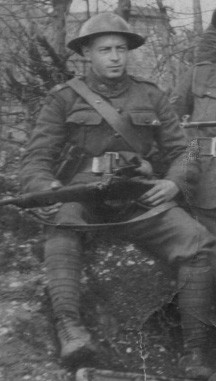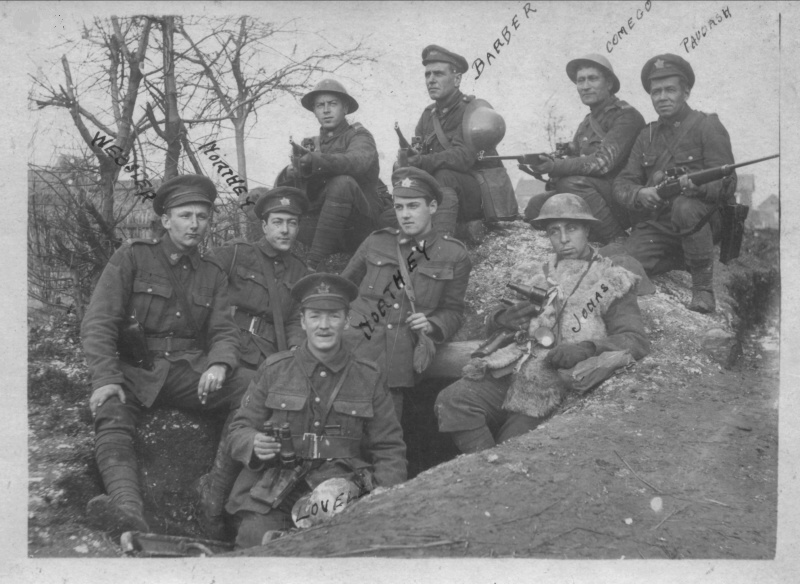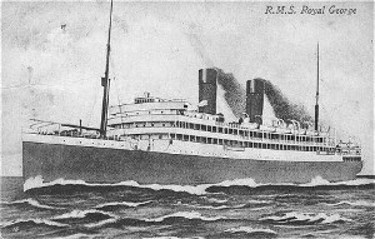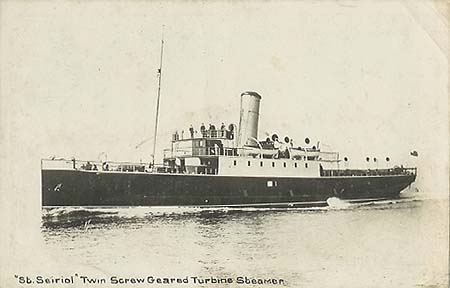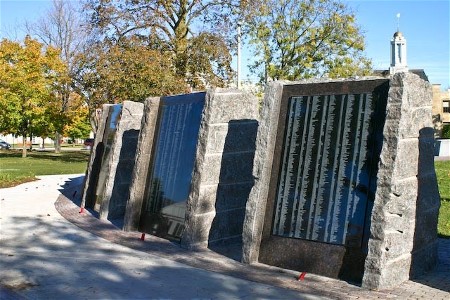|
SCOTT MONTGOMERY
FACTS & MEMORIES By his son, Roy Montgomery Scott's return to England was caused by the outbreak of World War I. According to the records held in the National Archives of Canada in Ottawa the wartime career of Scott started on 4 Nov 1914 when he enlisted in the 21st Battalion at Kingston, Ontario as Private 59667. Of interest is the copy of the Attestation Paper in which is the information that at that time his trade was that of a painter and that at that time his father as next of kin was living at Kings Hill, Beech. Information from the Paper shows that he was five feet seven inches tall, weighed 135 pounds, had a fair complexion with blue eyes and light coloured hair. He had a scar on the inner side front of right thigh and he also gave his religion as being Presbyterian. He was signed as being fit on 3 Nov 1914 before taking the oath the following day. With his father’s address of Kings Hill this confirms that the move of his parents from Middlesex to Beech was accomplished sometime before November 1914. Scott sailed for England in the RMS Metagama and disembarked on 15 May 1915, the next entry being that he forfeited one days pay for being AWOL on 1 Jun 1915 at a place called West Sandling. If this is Sandling in Kent then it was just outside of the town of Maidstone. After four months in England the regiment embarked for France on 14 Sep 1915, sailing from Folkstone and disembarking at Boulogne. The next entries in the records refer to two spells of leave whilst in France, the first being nine days from 24 Jan 1916, returning to duty on 3 Feb 1916, whilst the second was for 10 days from 13 Nov 1916, being back on duty again on 27 Nov 1916. It was during the regiments stay in England that Scott apparently met Florence GRACE as they were married at Postling, possibly near Folkstone, on 31 Jul 1915. Florence was born in 1890 to parents David and Susan who lived, along with four other children in Coldgrove Cottages in Taplow Buckinghamshire, her birth being registered at Eton, Bucks. In 1901 the family were still in the same cottages, at number 4, though by now Florence had three younger brothers and sisters. After this very little else is known about Florence apart from the fact that she was supposed to have been a nurse, probably as a result of the First World War, at one of the military hospitals. Very few photos exist from this time but there is one dated "Sept 1915" which shows a group of twenty two soldiers, including my Father with lance corporals stripes and holding a rifle with a telescopic sight, in a posed photograph. From the date it is possible that this was taken whilst still in England just before embarking for France. Two other photos, one of which has "snipers and observers, Nov 30th 1916, 21st Canada" written on the back, are of a group of nine soldiers in different positions in trench or dugout. Fortunately one of them has the name of each man written alongside the person which not only identifies them but also that the unnamed one is my Father!
The snipers holding rifles are my Father, Barber, Comego and Paudash, the observers holding binoculars are Jonas and Lovell, two others are named Northey possibly brothers and one of which was corporal, and the final one was Webster who had a pistol holster and was possibly the officer. Of these Comego, Paudash and Jonas were Canadian Indians. A newspaper cutting, presumably from a local Canadian paper also exists which was sent to my Father at some time and which shows a sniper and observer in a dug-out. The caption says "A Canadian sniper post in Courecelette village. On the left Pte L. Jonas of the 21st Kingston Battalion." The sniper is not named but it could have been Paudash. Written on it is "Do you remember when this was taken at Bully. I saw it in a paper and cut it out to let you see it."
At the moment not a great deal is known of Scott's military service except that he was a sniper, and presumably a successful one as he survived. Names that can be remembered in the stories that he used to tell are Vimy Ridge, Ypres and Hill 60 along with a few yarns of his experiences when operating as a sniper. On 1 May 1917 he was promoted to Acting Lance Corporal (without pay), a rank that he held until 22 Nov 1917 when he reverted back to the permanent rank of Private on admission to hospital. The next leave to be granted was for 10 days on 9 Nov 1917. This was obviously spent in England as on 22 Nov he was admitted to No. 15 Canadian General Hospital at Taplow in Buck for reasons unknown. In conjunction with this he was posted from 21 Battn to the 3rd Canadian Command Depot (3 CCD) at Seaford to be effective from the same date. Another reference is made of a posting to the Eastern Ontario Regimental Depot (EORD) also at Seaford. On discharge from hospital on 15 May 1918 he was taken back on strength at the 3rd CCD where he remained until being posted to No. 4 Canadian Hospital (4 CGH) at Basingstoke, Hants for general duties on 16 Aug 1918. From this it is not clear whether he briefly returned to France, remained at Seaford or spent the intervening three months somewhere else in the UK. It was during this spell in hospital that a son, Cleveland Harston, was born on 3 Feb 1918 although the event was tempered with tragedy as Florence died a couple of months later on 29 Mar 1918. Cleveland's birth was registered in Eton on 8 Mar 1918 and the certificate reveals that he was born at 4 Coldgrove Cottages in Taplow, Bucks, that Scott was in the "21st Canadian Expeditionary Force" and in brackets was (Painter and Decorator) which was an indication of what work he was doing when in Canada. The death certificate for Florence was issued on 27 March in Maidenhead and information on it shows that although her home was at 4 Coldgrove Cottages she in fact died in The Cottage Hospital in Maidenhead, Berks. A story exists that she died in childbirth but although this is obviously not true it may have had a bearing on the cause of her death. The cause of death was given as (1) Pyosalpinx, (2) Laparotomy and General Peritonitus by E. Cecil MONTGOMERY (no relation) who was presumably a doctor at the hospital. Pyosalpinx is either an infection or blood in the valopian tubes, Peritonitus is an inflammation of the membrane around the abdomen and laparotomy is the operation of cutting into the abdomen. Scott apparently stayed at 4 CGH until 7 May 1919 when he was transferred from that units strength to Depot Company, possibly at Seaford. From there he was struck off strength from to "H" Wing on 24 May 1919 for discharge in the UK, having apparently elected to remain in England rather than be repatriated to Canada and be discharged there. His discharge was effective at Seaford on 10 Jun 1919 and the discharge document shows that he had the 1914/15 Star as well as one wound stripe. The wound was apparently from a bullet in the right thigh as that scar is listed as a distinguishing feature. Due to the conflict of dates between his leave in England and admission to hospital it is unlikely that the bullet wound was the direct cause of his stay at Taplow, although it is quite possible that it was due to after effects once he was back in England. With Grace's family living in Taplow it could have been coincidence that Scott ended up in hospital there, but more likely it was due to him being taken ill whilst on leave with Florence at her parents home and that the Canadian hospital was conveniently close by. It may also be that the complaint had been "harboured" until near the end of his leave, which was a means of being able to stay in the area and near Florence who was heavily pregnant at that time. Among the stories that I can remember him telling are a number from the time when he was operating as a sniper. He used go out into no-mans land during the night and find a convenient shell hole in which he could set up for the next day before returning back to his own lines the next night. This must have been one of the few places where whatever the rank of the sniper he was in total command of the situation no matter who else was there. This was illustrated one time when an officer accompanied him out and wanted to light up a cigarette. This officer was told in no uncertain way to wait until given permission to do so by my Father, and this would only be given if they could smell the German coffee at breakfast time. If coffee could be smelt it meant that the wind was blowing from the German lines towards them and so the cigarette smoke would be blown away from the Germans. If coffee could not be smelt then the smoke would be blown towards the Germans and their position may have been compromised. Other similar tips which were all part of self preservation was never to shoot directly in front but always at an angle to the sides, and never to shoot at the same target more than once, no matter how obvious or good it was. By not shooting directly to the front it made it harder for any German observer to possibly spot the gun smoke before it dispersed, and once a target was shot at it also made a mark for the German observer to seek out the sniper so that if a second shot came in the same direction it made it a lot easier to identify the location. I also remember him saying that he used to blacken the foresight of his rifle with the smoke from a match, in certain conditions this made the foresight stand out against lighter coloured targets. A good lesson to remember was that there were probably just as many German snipers out in no-mans land as there were British, and they were obviously waiting for a target to present itself. At one time he was also an instructor at a snipers school but I cannot remember if this was when he was in France or later on back in England. Not all the stories were of self preservation because I can remember one from when my Father had gone out at night and while it was still dark he could see something white keep flashing over a nearby German trench. Unable to figure out what this was he kept watch until dawn began to break and then it became obvious that the flashes of white was chalk being thrown up into the air. Seemingly the Germans were digging a trench and that one particular soldier when throwing his shovel full of chalk out of the trench was throwing it higher than anybody else and it was this that kept flashing. A story that illustrates these points was that my Father passed a couple of soldiers standing up in the trenches and having great fun shooting at something. When he asked what they were shooting at it was apparently a German hosepipe. They were pumping out one of their trenches and had thrown the pipe over the top to drain the water away. The effect of shooting holes in the pipe meant that as the pump was working so the water squirted all over the place. My father warned them that they were asking for trouble but they took no notice and obviously carried on because when he came back later there was only one of them. When asked what had happened the reply was that when his mate was shooting at the pipe a German sniper had shot him clean through the forehead. Not all the tales came from action in the front line either. One way of getting back at some of the officers who had upset them was to cut long hair from the tail of white horse and then put it in the officer’s bed. Supposedly when he had gone to bed the body heat caused the hair to start twitching which caused a certain amount of discomfort and when the person looked to see what was wrong because the hair was white it was almost invisible. Another tale was from England and was one of the times when my Father was coming home on leave. He was in a crowded train without any seats and so was standing up. Another soldier in the same situation told him to wait a while and they would have all the seats they wanted. He then started scratching as though he was infested with lice and it wasn't long before the other passengers got up and left one by one until that compartment was empty - they then had all the seats to themselves. One final story that he told was that he was to be recommended for the Military Medal but according to him he "exchanged " the award for a spell of leave in the UK; to use his words "this being more useful than a lump of metal". It is interesting to speculate that this "negotiated" leave was the one that commenced on 9 Nov 1917 and that this was the direct result of some action during which he was wounded. If this speculation was true then it was understandable as back home he had a young wife with a baby on the way. However, whether this story was true or not he was awarded 1914/15 Star and he also had the British War Medal 1914-1920 and the Victory Medal 1918. Certainly for a few years after the war finished he kept up correspondence with at least one of his war comrades, Jack Barber, because a letter from Jack and addressed to "The Alps" and written in September 1921 has survived. Apparently Jack married a London girl named Edie and then took her back to Fenlon Falls in Ontario but the letter rather tragically describes her death in July 1921. From the content of the letter it looks as though my Father and Jack had known each other in Canada before they enlisted in the Canadian Army, both had joined the same unit and had survived the war with Jack returning to Canada for demobilization, taking his bride with him. Reproduced here with permission of the author © Roy Montgomery 2007 Not to be reproduced in any form without permission of the author |
||||||||||||||||||||||||||||||||||||||||||||||||||||||||||||||
The following is additional
research by Al Lloyd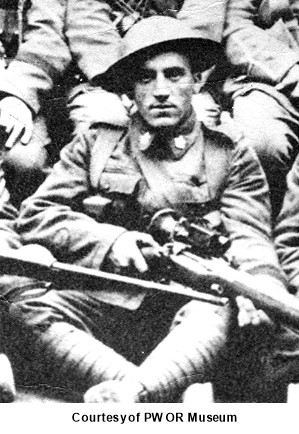
|
||||||||||||||||||||||||||||||||||||||||||||||||||||||||||||||

